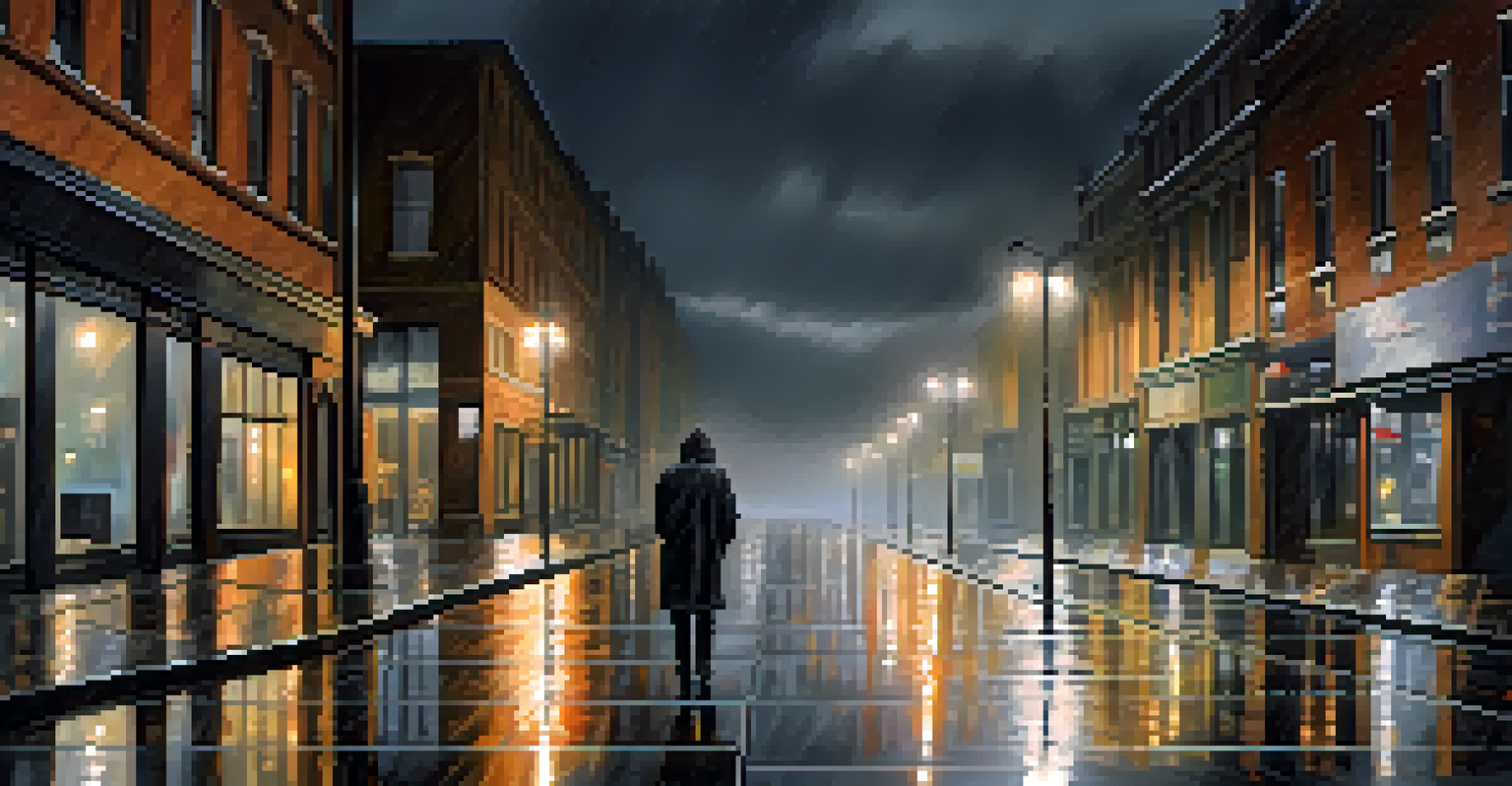Show, Don’t Tell: The Power of Visual Elements in Storytelling

Understanding the Concept of Show, Don’t Tell
At its core, 'Show, Don’t Tell' is a storytelling technique that emphasizes illustrating emotions and experiences rather than simply stating them. This approach allows the audience to immerse themselves in the narrative, feeling the weight of the characters’ journeys. For instance, instead of saying a character is sad, you might describe their slumped shoulders and downcast eyes, painting a vivid picture.
The best way to predict the future is to create it.
This technique invites readers or viewers to engage their imagination, creating a more memorable experience. When you're shown a scene, like a character standing alone in the rain, you can feel the isolation and despair without needing explicit words. It's this depth that makes storytelling resonate on a personal level.
Ultimately, mastering 'Show, Don’t Tell' can elevate your storytelling, creating an emotional connection with your audience. It transforms passive consumption into active engagement, making your narrative not just read but felt.
The Role of Visual Elements in Storytelling
Visual elements, such as images, colors, and symbols, play a crucial role in storytelling by enhancing mood and context. For example, a vibrant sunset can evoke feelings of hope, while dark clouds might signal impending doom. These elements work synergistically with the narrative to create a richer experience.

Think of movies where cinematography and set design bring the story to life. A well-placed visual can convey emotions that words may struggle to articulate. This interplay between visuals and narrative creates a multi-layered experience, allowing audiences to connect deeply with the story.
Show, Don’t Tell in Storytelling
This technique emphasizes illustrating emotions and experiences to create a deeper connection with the audience.
Incorporating strong visual elements can also help clarify complex ideas. For instance, infographics can simplify data, making it more digestible and engaging. By using visuals effectively, storytellers can communicate their message with greater clarity and impact.
Examples of Visual Storytelling in Film
Films often exemplify the power of visual storytelling, using imagery to convey themes and emotions without relying solely on dialogue. Take 'The Shawshank Redemption,' where the iconic imagery of Andy Dufresne standing in the rain symbolizes freedom and renewal. Such moments stick with the audience long after the credits roll.
A picture is worth a thousand words.
Another great example is 'WALL-E,' which tells a poignant story largely through visuals and minimal dialogue. The character's journey is expressed through his actions and the world around him, drawing viewers into the narrative without overwhelming them with words. This allows for a universal connection, transcending language barriers.
These examples illustrate that powerful visuals can often communicate more effectively than words alone. By showcasing emotions, settings, and character development visually, filmmakers create a memorable experience that resonates deeply with audiences.
The Impact of Color in Visual Storytelling
Color is a potent tool in visual storytelling, influencing emotions and perceptions. Different colors can evoke specific feelings; for example, blue often represents calmness, while red can signify passion or danger. By choosing the right color palette, storytellers can enhance the emotional weight of their narratives.
Consider the film 'The Sixth Sense,' which uses color strategically to signify the presence of ghosts. The subtle shifts in color throughout the film help create suspense and tension, guiding viewers' emotional responses. This meticulous attention to color elevates the storytelling experience.
The Power of Visual Elements
Visual components like color and imagery enhance storytelling by evoking emotions and providing context.
Incorporating color thoughtfully can also help clarify character motivations and themes. For instance, a character dressed in bright colors may symbolize optimism, while darker hues could indicate internal conflict. By understanding the psychological effects of color, storytellers can craft more impactful narratives.
Using Symbolism to Enhance Visual Narratives
Symbolism adds depth to visual storytelling by embedding deeper meanings within images. A simple object, like a withering flower, can represent lost hope or a character's emotional state. By using symbols, storytellers can convey complex themes without overt explanations.
In literature, F. Scott Fitzgerald's 'The Great Gatsby' uses the green light at the end of Daisy's dock as a powerful symbol of Gatsby's unreachable dreams. Similarly, films utilize visual symbols to encapsulate themes and emotions, enriching the narrative experience.
Incorporating symbolism encourages audiences to engage more actively with the story. When viewers recognize and interpret these symbols, it creates a shared understanding that can enhance the emotional connection to the story.
The Importance of Composition and Framing
Composition and framing are essential aspects of visual storytelling, guiding viewers' attention and shaping their understanding of a scene. The way elements are arranged within a frame can convey relationships, power dynamics, or emotional states. For example, a close-up shot can create intimacy, while a wide shot may suggest isolation.
In photography and film, the rule of thirds is a common technique used to create visually appealing compositions. By positioning subjects along these lines, storytellers can draw the viewer’s eye to what’s important, enhancing the narrative flow. This intentional framing helps maintain engagement and interest.
Symbolism Enriches Narratives
Using symbolism adds layers of meaning to visuals, encouraging audience engagement and enhancing emotional resonance.
Understanding composition allows storytellers to utilize space effectively, creating a balance between visuals and narrative. By mastering these techniques, creators can craft scenes that not only tell a story but also evoke emotional responses from the audience.
Combining Visuals with Text for Maximum Impact
The integration of visuals with text can create a powerful storytelling experience. Infographics, for instance, combine data with images to tell a story at a glance, making complex information more accessible and engaging. This blend caters to different learning styles, ensuring a broader audience reach.
In literature, authors often use descriptive language to paint vivid pictures in readers' minds, enhancing the overall experience. By weaving visual descriptions into the narrative, writers can create immersive worlds that readers can easily visualize and connect with.

Utilizing visuals alongside text allows storytellers to appeal to both emotional and intellectual engagement. This dual approach not only enhances understanding but also leaves a lasting impression, making the story more relatable and memorable.